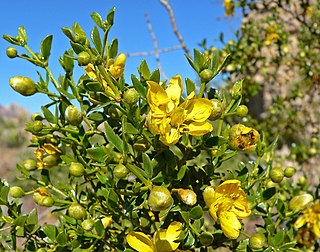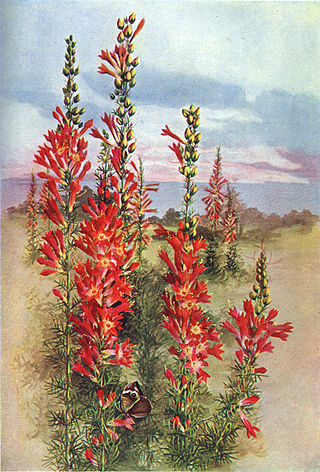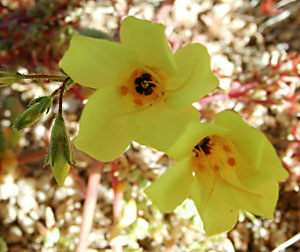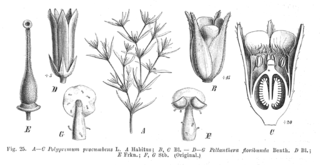
The Polygonaceae are a family of flowering plants known informally as the knotweed family or smartweed—buckwheat family in the United States. The name is based on the genus Polygonum, and was first used by Antoine Laurent de Jussieu in 1789 in his book, Genera Plantarum. The name may refer to the many swollen nodes the stems of some species have, being derived from Greek [poly meaning 'many' and gony meaning 'knee' or 'joint']. Alternatively, it may have a different origin, meaning 'many seeds'.

Meliaceae, the mahogany family, is a flowering plant family of mostly trees and shrubs in the order Sapindales.

The Francoaceae are a small family of flowering plants in the order Geraniales, including the genera Francoa, commonly known as bridal wreaths. The Francoaceae are recognized as a family under various classification schemes. Under the 2009 APG III system the Francoaceae were included within the Melianthaceae. In the 2016 APG IV system the Francoaceae are again recognized as a family, with Melianthaceae included in the circumscription of Francoaceae.

Zygophyllaceae is a family of flowering plants that contains the bean-caper and caltrop. The family includes around 285 species in 22 genera.

Gesneriaceae, the gesneriad family, is a family of flowering plants consisting of about 152 genera and ca. 3,540 species in the tropics and subtropics of the Old World and the New World, with a very small number extending to temperate areas. Many species have colorful and showy flowers and are cultivated as ornamental plants.

Linanthus is a genus of annual and perennial plants in the phlox family Polemoniaceae. The species are found in western North America and in Chile, with the greatest diversity in California.

Chrysobalanaceae is a family of flowering plants, consisting of trees and shrubs in 27 genera and about 700 species of pantropical distribution with a centre of diversity in the Amazon. Some of the species contain silica in their bodies for rigidity and so the mesophyll often has sclerenchymatous idioblasts. The widespread species Chrysobalanus icaco produces a plum-like fruit and the plant is commonly known as the coco plum.

Ipomopsis aggregata is a species of biennial flowering plant in the phlox family, Polemoniaceae, commonly known as scarlet trumpet, scarlet gilia, or skyrocket because of its scarlet red flowers with lobes curving back as if blown back by rocketing through the air.

Ipomopsis is a genus of flowering plants in the phlox family, Polemoniaceae. The annual and perennial herbs it contains are native to the Americas, particularly North America.

Gilia is a genus of flowering plants in the Polemoniaceae family and is related to phlox. It includes 39 species native to the Americas, ranging from British Columbia to Texas and northern Mexico, and to Ohio, in North America, and from Ecuador and Peru to southern Chile and Argentina in South America. These Western native plants are best sown in sunny, well-draining soil in the temperate and tropical regions of the Americas, where they occur mainly in desert or semi-desert habitats

Leptosiphon is a genus of flowering plants in the Polemoniaceae family. Many included species were formerly classified as members of the genus Linanthus. Some species of this genus are grown as ornamental plants.

Cantua is a genus of flowering plants in the family Polemoniaceae which is in the order Ericales. They are restricted to central South America where many species are endemics in the countries of occurrence.

Aliciella is a genus of plants in the phlox family. It includes 23 species native to the western United States and northwestern Mexico. These plants have been treated as members of genus Gilia until recently, when it was proposed they be moved back to Aliciella. This genus was created in 1905 to include certain gilias that seemed distinct from most of the others, but it was abandoned soon after. Recent genetic analyses suggest it should be revived.
The APG III system of flowering plant classification is the third version of a modern, mostly molecular-based, system of plant taxonomy being developed by the Angiosperm Phylogeny Group (APG). Published in 2009, it was superseded in 2016 by a further revision, the APG IV system.

Acanthogilia is a genus that contains a single species of desert shrub from Baja California, Mexico. It was first scientifically described as a genus in 1986.

Saltugilia is a genus of flowering plants in the phlox family, Polemoniaceae. They are known commonly as woodland gilias. There are four species. Two are endemic to California in the United States, and the distributions of the other two extend into Baja California in Mexico.

Peltanthera is a genus of flowering plants containing a single species, Peltanthera floribunda. The genus was originally placed in family Loganiaceae and has since been variously placed in Buddlejaceae, Scrophulariaceae, Gesneriaceae, or in its own family Peltantheraceae. In 2016, it was considered by the Angiosperm Phylogeny Group to be unplaced in any family, but within the order Lamiales, while Christenhusz et al. in 2017 placed it in family Gesneriaceae as subfamily Peltantheroideae. The placement in Gesneriaceae was accepted by Plants of the World Online as of March 2024.

Ipomopsis rubra is a flowering plant of the phlox family native to North America in the state of Texas and the southeastern United States, commonly known as standing cypress, scarlet gilia, Texas plume, flame flower, and indian spur. This classification is synonymous with Gilia rubra. This flower is noteworthy for its bright, upturned flowers.

Loeselia is a genus of flowering plants in the phlox family Polemoniaceae, native to the southwestern United States, Mexico, Central America, Columbia and Venezuela. A number of species are found only in the Balsas Depression of southwestern Mexico.
















